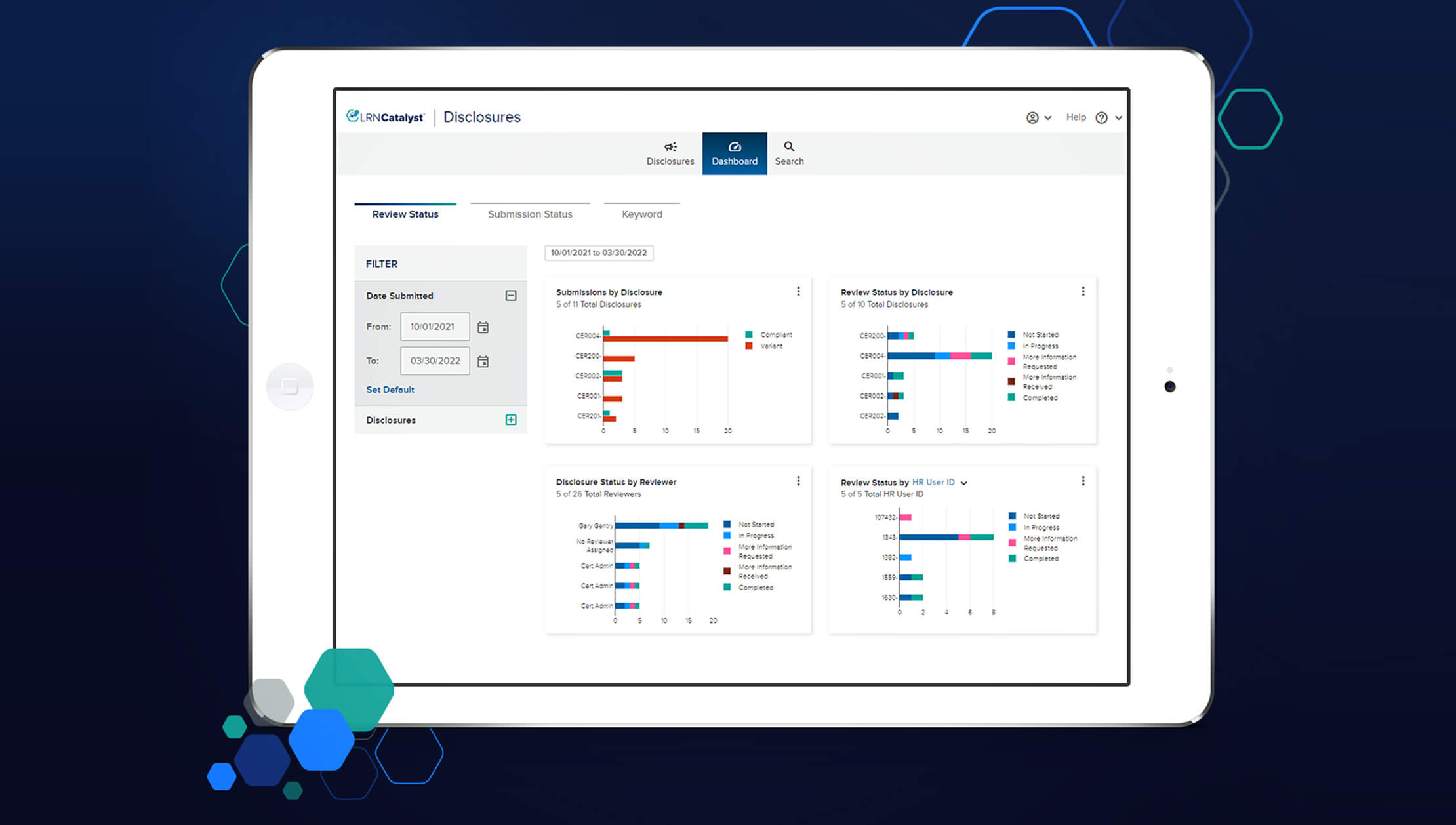A conflict of interest may arise in the workplace because of various factors. This includes romantic relationships at work, relationships of close family members with business or financial interests at a supplier or customer of the company, non-compete considerations in the employment contract, or gift giving to decision makers.
To guide employees about actual or potential conflicts of interest, organizations usually develop a code of conduct that clearly outlines what constitutes a conflict of interest in the workplace. They will also create documents and training to ensure employees understand what is expected of them. Finally, they will develop processes for disclosing potential conflicts of interests or other types of risks.
How a disclosures tool helps manage conflicts of interest and other risks
A disclosures tool makes it easy for employees to share potential conflicts of interest with the compliance team and get support on how to resolve them. According to a recent quick poll conducted by LRN, conflicts of interest remain the most common use case for clients, followed by gifts and entertainment and contractor disclosures.
It’s important to note, however, that disclosure collection has grown to include topics like continuing professional development, COVID-19 acknowledgment, work-from-home policies, harassment, supplier and contractor disclosures, and anti-competition—just to name a few. And as regulatory guidance continues to evolve, there’s a growing focus on reporting mechanisms, investigations, and dynamic approaches. As a result, tools like LRN’s Catalyst Disclosures are being developed in conjunction with current and former compliance and legal officers to streamline the process of data collection, review, and resolution of disclosure.
6 questions to ask when choosing your disclosures tool
According to the LRN 2022 Ethics & Compliance Program Effectiveness Report, 66% of high-impact risk programs across the globe said that greater use of digital certifications from employees in lieu of on-site audits and compliance reviews is a high priority for the coming year. If you are in the market for a tool to manage conflicts of interest or other types of disclosures, consider the following questions before making your decision.
- Does the tool support question and response customizations? Disclosure tools come in all shapes and forms. Some only allow for light customization. A true enterprise tool will allow for extensive customizations, support multiple question and response types including attachments, allow for follow-up questions based on initial responses, and remember responses from prior years for easy updates in future years.
- What post disclosure workflows are supported? Many buyers focus extensively on the data collection process of the tool. They think of the tool as a glorified survey. That is a mistake. While the ability to collect data about conflict of interest is important. It is equally important to have a tool that has a strong workflow behind the tool. The tool should allow various reviewers to be added to the tool, with escalations and exclusion based on rules. The tool should have an email functionality to document follow-up communications and attachments between the employee and the compliance officer, plus an easy way to track the information in the tool.
- Do disclosures integrate with training? While certain disclosures are event driven—for example, you may want to fill out a disclosure before giving a gift—many disclosures are annual. Because of these differences, it’s important to have a disclosure tool that can be deployed as standalone tool or as part of a training campaign. With Catalyst Disclosures for instance, after completing a training on code of conduct, an employee can immediately disclose any conflict of interest.
- Can the tool support multiple compliance workflows? A product offering that is limited to only a few well-defined cases can reduce your overall return on investment on the tool. A great disclosures tool would allow for all the standard use cases—such as conflicts of interest, gift giving, gift receiving, travel and entertainment—and also allow for unique use cases that may arise from time to time. Recently, a client of LRN used the disclosure tool to capture COVID-19 vaccination status and proof of vaccination, so they could gather information to allow employees to return to work.
- How does the tool meet technology and security needs such as performance, GDPR, and other data privacy requirements? Selecting a disclosures tool that does not run on an enterprise cloud platform will likely have uptime and responsiveness issues. Inquire about the tool provider’s infrastructure and security standards, such as ISO 27001. This can help ensure you are not buying a product that will have issues with responsiveness or additional headaches related to personally identifiable information (PII) or data breaches.
- What is the roadmap of offering? A technology tool that does not have an active development queue will quickly get left behind as new user experiences are developed. Inquire how the disclosures tool vendor is innovating, how large the development team is, and what features are planned for the short- and long-term roadmap. This will give you a sense of both the health of the vendor and the heath of the tool.
The key takeaway
While choosing a disclosures tool may feel daunting with various options in the market, selecting a tool that is flexible, integrated, while being secure and forward leaning will ensure that your investment is well protected. To learn more about ways to effectively manage risk, check out these resources:



